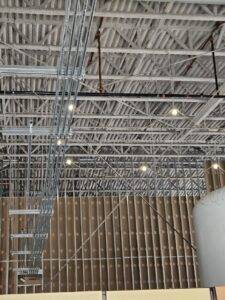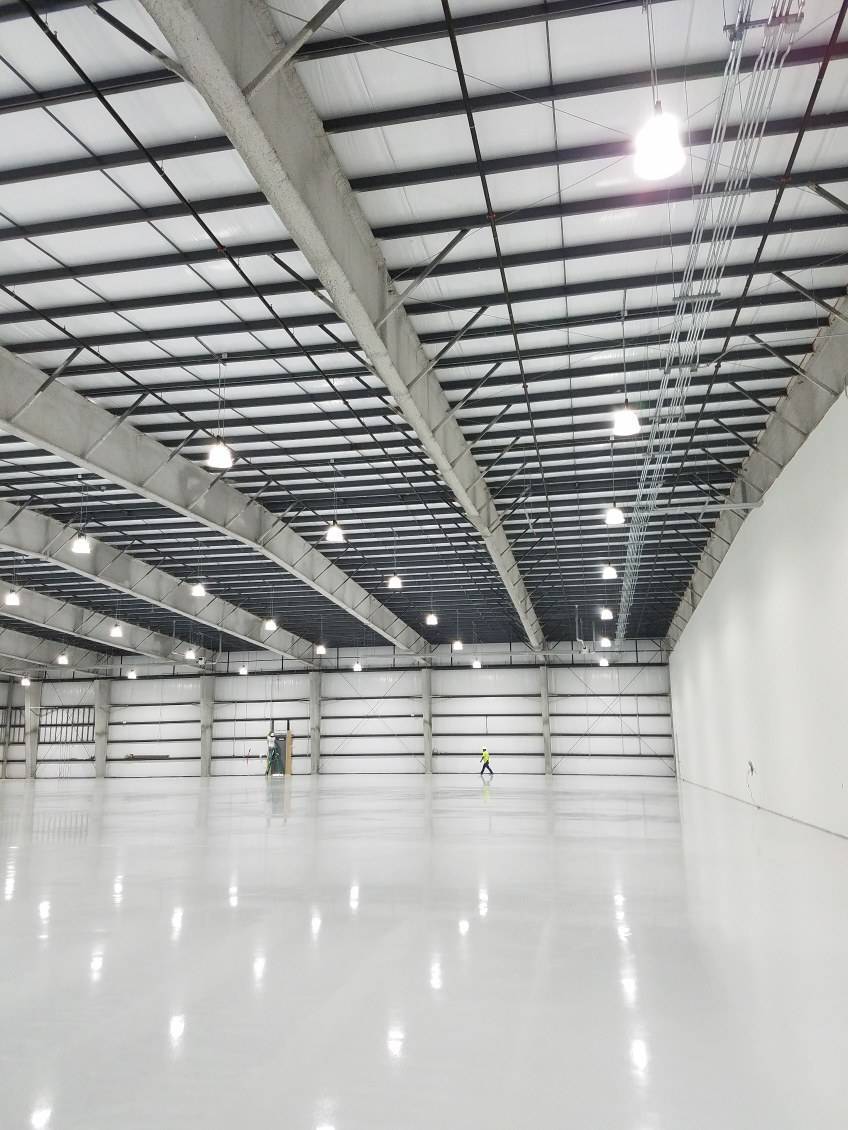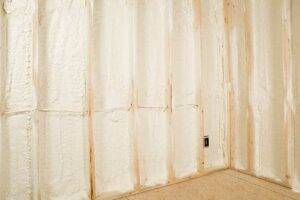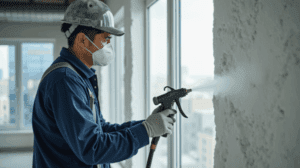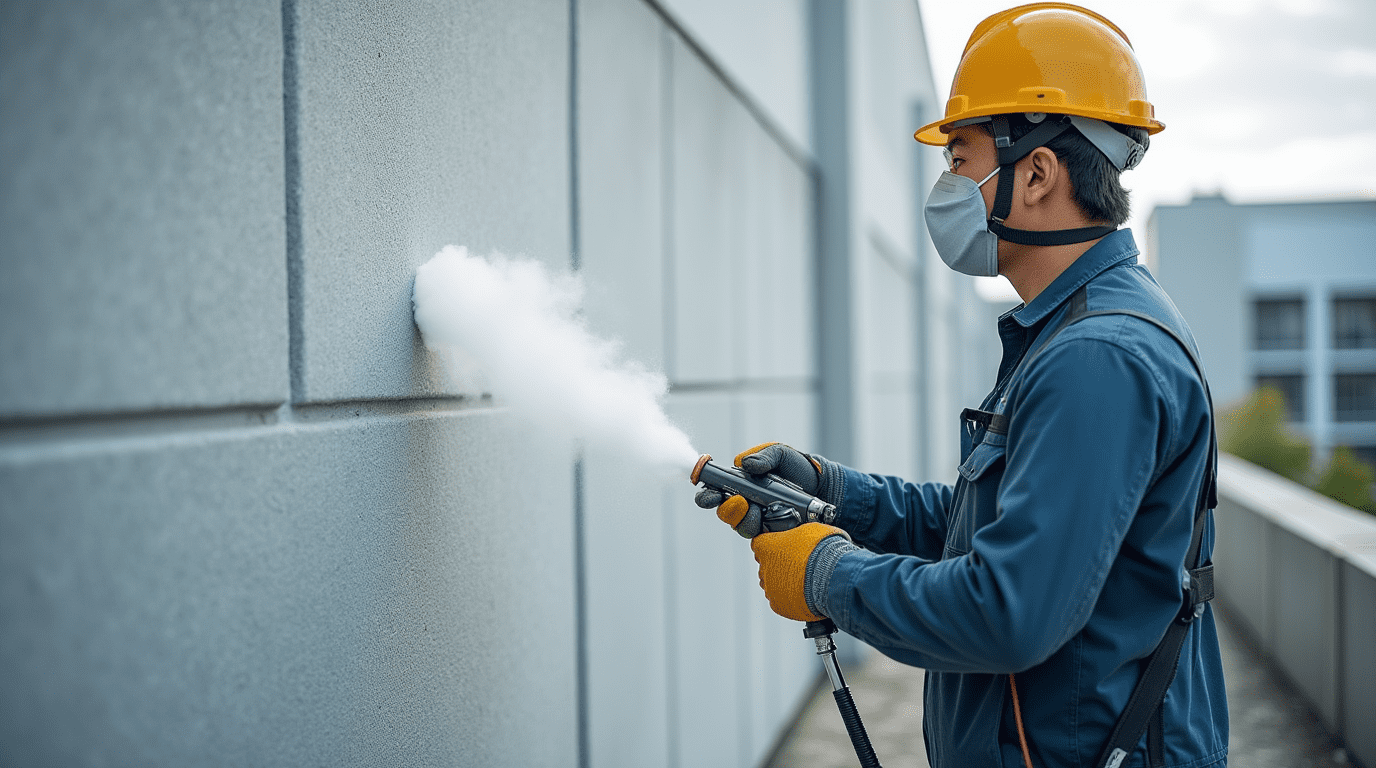Understanding K-13 Insulation Pricing for Commercial Projects
Bahl Fireproofing
When facility managers evaluate spray-applied insulation for commercial buildings, pricing represents just one component of the investment decision. The real question isn’t what K-13 costs per square foot. It’s what value that investment delivers over the building’s lifetime through energy savings, acoustic performance, and maintenance-free operation. Understanding K-13’s pricing structure, the factors that affect installation costs, and how this investment compares to alternatives helps you make informed decisions about your facility’s insulation needs.
TLDR: K-13 spray fiber insulation typically costs $1.50 to $3.00 per square foot installed for commercial projects. Pricing within this range depends on project size, application thickness, building height and access requirements, substrate conditions, and geographic location. This mid-range pricing delivers combined thermal insulation (R-3.7 per inch), acoustic absorption (NRC up to 1.05), and fire-rated finish in a single application, often providing better lifecycle value than cheaper alternatives requiring separate acoustic treatments or periodic replacement. With typical payback periods of 2 to 5 years through energy savings and potential Section 179D tax deductions of $0.50 to $5.00 per square foot, K-13’s upfront cost represents a solid long-term investment for facilities requiring both thermal and acoustic performance.
What Determines K-13 Pricing in Your Facility
K-13 spray-applied insulation pricing depends primarily on six factors: project size, application thickness, building height and access, substrate conditions, project complexity, and geographic location.
Project size creates economy of scale. Larger projects distribute mobilization costs across more square footage, reducing per-unit costs. A 10,000 square foot facility typically receives pricing near the lower end of the range, while a 1,000 square foot space approaches the higher end.
Application thickness affects material costs and labor time. Standard commercial applications range from 1.5 to 3 inches, delivering R-5.6 to R-11.1. Thicker applications require multiple spray passes, with material consumption and labor time scaling with thickness.
Building height and access requirements impact labor costs. Ground-level applications with straightforward access allow efficient operations. High ceilings require lifts or scaffolding, adding equipment costs and slowing application. Difficult access from narrow spaces or numerous obstacles increases installation time.
Substrate conditions determine preparation requirements. According to ASTM testing standards, proper surface preparation is critical for long-term performance. Clean substrates accept K-13 at standard pricing, while contaminated surfaces requiring cleaning or priming add labor time and material costs.
Project complexity encompasses penetrations, masking requirements, and coordination challenges. Open ceiling spans allow rapid coverage, while extensive HVAC, electrical, and structural elements require careful application around obstacles. Occupied buildings needing phased installation create scheduling challenges affecting efficiency.
Geographic location influences costs through regional labor rates, material availability, and market conditions. Labor rates vary across our service areas in Texas, Kansas, and Oklahoma, with urban markets typically commanding higher rates than rural areas.
How K-13 Pricing Compares to Alternative Insulation Systems
K-13 at $1.50 to $3.00 per square foot sits between budget materials like fiberglass batts ($0.40 to $0.70) and premium closed-cell spray foam ($3.00 to $7.00). This mid-range pricing reflects K-13’s combined functionality: thermal resistance, acoustic absorption, and fire-rated finish in a single application.
Closed-cell spray foam delivers higher R-value per inch (R-5 to R-7) but has poor acoustic performance (NRC around 0.70). Facilities needing noise control must add separate acoustic panels, often eliminating cost advantages. Open-cell spray foam ($1.00 to $4.50 per square foot) offers similar thermal performance but lower acoustic characteristics than K-13.
Fiberglass batts at $0.40 to $0.70 per square foot appear attractive initially, but real-world thermal performance typically degrades within 15 to 20 years due to compression and moisture. Batts also leave gaps at connections, reducing both thermal and acoustic performance. According to Energy.gov’s insulation guidance, matching material properties to building requirements ensures optimal performance.
Blown-in cellulose offers the lowest upfront cost at $0.70 to $0.80 per square foot but settles over time, requiring periodic topping. Mineral wool acoustic panels match K-13’s sound absorption (NRC 0.95 to 1.05) but cost $1.00 to $2.50 per square foot and require complex mechanical fastening rather than seamless spray application.
Understanding Labor Costs and Installation Efficiency
Labor represents 50 to 60 percent of total K-13 installation costs. Installation labor includes substrate preparation, equipment setup and calibration, spray application with multiple passes, quality control procedures (density testing, thickness verification), and cleanup activities. Regional labor rates typically range from $40 to $80 per hour.
Installation efficiency varies significantly based on project conditions. Open ceiling spans with good access allow rapid coverage. Complex geometries, difficult access requiring lifts, or occupied building constraints requiring limited work hours all reduce coverage rates and increase labor time. Professional K-13 installation includes quality control during application, with licensed applicators continuously monitoring coverage, verifying density through core samples, and measuring thickness to ensure 75-year rated performance.
Return on Investment and Energy Savings
K-13’s pricing makes sense when evaluated against the energy savings it delivers over the building’s lifecycle. Facilities upgrading from minimal insulation to properly applied K-13 typically see energy cost reductions of 20 to 30 percent, though results vary based on climate zone, building envelope quality, HVAC system efficiency, and operational patterns. These savings create payback periods typically ranging from 2 to 5 years.
A 10,000 square foot commercial facility spending $15,000 to $30,000 for K-13 installation might realize annual energy savings of $3,000 to $6,000, depending on energy costs and climate conditions. Over 10 years, return on investment typically ranges from 150 to 250 percent. These figures represent real operational savings that continue throughout the building’s life, not one-time benefits.
However, energy savings alone don’t capture K-13’s full value proposition. The acoustic performance delivered in the same application provides measurable benefits through reduced worker fatigue, improved productivity, and enhanced occupant satisfaction. These benefits have real economic value, even if they’re harder to quantify than energy cost reductions. Manufacturing facilities with equipment noise, call centers requiring speech privacy, and gymnasiums with reverberation issues all benefit from K-13’s acoustic capabilities in ways that affect operational efficiency and user experience.
Federal tax incentives significantly impact K-13’s net investment cost. According to IRS Section 179D guidance, properly documented insulation installations meeting energy efficiency thresholds can qualify for tax deductions ranging from $0.50 to $5.00 per square foot. On a 10,000 square foot project, this represents potential tax benefits from $5,000 to $50,000. However, Section 179D qualification depends on comprehensive energy modeling and meeting specific performance thresholds, not just insulation installation alone. Building owners should consult with tax professionals and energy modelers early in project planning to maximize these benefits.
Lifecycle Cost Considerations
K-13’s 75-year service life means one installation serves the facility’s entire useful life with no replacement costs and minimal maintenance. This contrasts with alternatives requiring periodic replacement or ongoing maintenance.
Fiberglass batts may require supplemental insulation every 15 to 20 years as performance degrades, with each replacement involving material costs, labor, disposal fees, and building disruption. Blown-in cellulose requires periodic topping to compensate for settling, adding maintenance costs particularly challenging for difficult-to-reach commercial ceilings. K-13’s spray-applied installation maintains thickness and performance without settling.
The elimination of separate acoustic treatments represents another lifecycle advantage. Facilities choosing spray foam for thermal performance often need additional acoustic panels to control noise, adding material costs, labor, and coordination complexity. K-13 delivers both thermal and acoustic performance in the initial installation.
When K-13 Delivers Optimal Value
K-13 pricing makes the most sense for building types where combined thermal and acoustic performance addresses multiple facility needs simultaneously. Gymnasiums, auditoriums, manufacturing facilities with equipment noise, call centers and offices requiring speech privacy, educational facilities, and parking garages all benefit from K-13’s dual functionality. The fire-rated finish eliminates separate ceiling materials in parking garages.
Some applications may benefit more from alternatives. Cold storage facilities requiring maximum R-value per inch often justify closed-cell spray foam’s premium pricing. Simple attic spaces without acoustic concerns may find adequate performance from blown fiberglass or cellulose at lower costs. The key is matching material selection to facility requirements: K-13 delivers optimal value when buildings need both thermal and acoustic benefits in a single application.
Cost-Saving Strategies Without Compromising Quality
Facility managers can optimize K-13 costs through several strategies. Bundling multiple spaces or coordinating with other facility work increases project size, improving per-square-foot pricing through economy of scale. Scheduling during contractors’ slower seasons can yield better rates. Simplifying access by clearing work areas and coordinating other trades before K-13 application reduces labor time.
Pre-cleaning substrates when facility staff can handle this work may reduce preparation costs. Coordinating all roof penetrations, hangers, and sleeves before K-13 installation avoids cutting through completed insulation later. Pursuing Section 179D tax deductions early ensures proper documentation and energy modeling to maximize benefits.
What doesn’t save money: choosing unqualified contractors based on low bids, reducing specified thickness below facility needs, or skipping quality control. These apparent savings create problems when correction costs far exceed any initial price advantage.
Budget Planning and Cost Breakdown
Material costs typically represent 30 to 40 percent of total installed price, labor accounts for 50 to 60 percent, and equipment and overhead make up 10 to 20 percent. For a 5,000 square foot facility, K-13 typically costs $7,500 to $15,000 installed. A 10,000 square foot project ranges from $15,000 to $30,000, benefiting from economy of scale. Projects under 1,000 square feet may approach $2,500 to $3,000, with higher per-square-foot pricing.
Budget planning should include contingencies for substrate preparation if conditions reveal contamination requiring correction. Allow for potential priming requirements and factor coordination time if the facility remains occupied during installation.
Key Takeaways
K-13 spray fiber insulation typically costs $1.50 to $3.00 per square foot installed, with pricing within this range determined by project size, application thickness, building height and access, substrate conditions, project complexity, and geographic location. This mid-range pricing delivers combined thermal insulation (R-3.7 per inch), acoustic absorption (NRC up to 1.05), and fire-rated finish in a single application.
Compared to alternatives, K-13 costs more than basic fiberglass batts or blown-in cellulose but less than closed-cell spray foam or mineral wool acoustic panels. However, direct price comparison without considering performance differences and lifecycle costs overlooks K-13’s value proposition. Materials requiring separate acoustic treatments to match K-13’s sound control performance often exceed K-13’s total installed cost while adding project complexity.
Energy savings typically create payback periods of 2 to 5 years, with facilities seeing 20 to 30 percent reductions in heating and cooling costs, though results vary based on climate, building conditions, and operational patterns. Over 10 years, return on investment typically ranges from 150 to 250 percent. Section 179D tax deductions can reduce net costs by $0.50 to $5.00 per square foot when projects meet energy efficiency thresholds and include proper documentation.
K-13’s 75-year service life eliminates replacement costs and maintenance requirements that affect alternatives. Fiberglass may need supplemental insulation every 15 to 20 years as performance degrades. Blown cellulose requires periodic topping to compensate for settling. K-13’s single installation serves the building’s entire useful life with maintained performance, avoiding recurring costs that accumulate over decades.
Optimal value comes from matching K-13 to applications requiring both thermal and acoustic performance: gymnasiums, manufacturing facilities, call centers, educational buildings, and parking garages. Facilities needing only thermal resistance without acoustic concerns may find adequate performance from less expensive alternatives. Those requiring maximum R-value per inch may justify spray foam’s premium pricing despite acoustic limitations.
If your commercial facility requires insulation that delivers both energy efficiency and noise control with fire-rated finish in a single maintenance-free application, K-13 pricing represents a solid long-term investment. Contact Bahl Fireproofing today to discuss your project requirements and receive accurate pricing based on your specific conditions. Our certified applicators ensure proper installation that delivers rated performance and maximizes your investment value over the building’s lifetime.
Disclaimer: This article provides general educational information about fireproofing and insulation systems and does not constitute professional engineering advice or product specification. System selection must be based on project-specific fire ratings, thermal requirements, acoustic performance needs, environmental conditions, substrate requirements, and budget constraints. Code requirements vary by jurisdiction and project type. Always consult with a licensed professional and verify UL or FM assembly listings before finalizing specifications.

